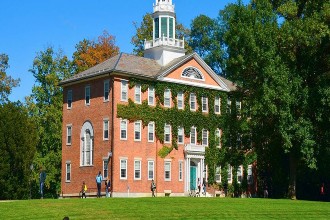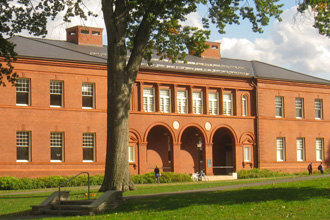CLAREMONT MCKENNA COLLEGE
REQUIREMENTS AND CAMPUS GUIDE
School Name: Claremont McKenna College
School Location: Claremont, CA
School Type: Private Liberal Arts
Claremont McKenna College Admissions Rates Class of 2025
Applications: 5,632
Admitted: 11.2%

General Info
SAT/ACT Score
Test Optional for 2022-2023
Admission Cycle
Fall 2021 Test Scores
Math: 720-780
ERW: 700-750
ACT: 32-35
Dates/Deadlines
Early Decision 1: November 1
ED 1 Results: By December 15
Early Decision 2: January 10
ED 2 Results: February 15
Regular Deadline: January 10
Regular Results: By April 1
School Information
Schedule: Semester
Curriculum Type: General Education
Greek Life: No
Athletics: DIII
CLAREMONT MCKENNA TIPS & GUIDE
Claremont McKenna Application Requirements, Admissions Tips, and University Guide
Claremont-Mckenna College is an applied liberal arts college in Claremont, CA. Claremont is the town of “trees and PhDs”—it’s a classic, cozy college town buzzing with intellectual energy. CMC is part of a five-college consortium modeled after The University of Oxford. You can read all about it below!
How do I apply?
Claremont-Mckenna doesn’t have strict requirements for high school courses, but it does have recommended courses. (When a college recommends something, you should always take it as seriously as you would a requirement.) By the time you apply, you should have taken 4 years of English, 4 years of math, 3 years of a foreign language, 2 years of science, and 1 year of history. You can apply to CMC through the Common Application, the Coalition Application, or the Questbridge Application. If you apply through the Common App or Coalition app, you’ll also need to submit two supplemental essays. The first is “Why do you want to attend Claremont McKenna College?” and the second asks you to choose a course from a list of Freshman Writing Seminars and Freshman Humanities Seminars and elaborate on your interest in the topic. Two other “recommendations” are interviews and video supplements. The interview is conducted virtually through fall 2022, and is typically about 30 minutes long, while the video is a two-minute video you submit with your application. Both the interview and video provide you with an opportunity to demonstrate your uniqueness and offer an authentic glimpse of your personality. If you were unable to schedule an interview, CMC strongly recommends that you submit a video.
Is CMC hard to get into?
Claremont-Mckenna is a high reach for most students, even if you have great test scores and an impressive resume. 643 of the 5,642 students who applied to the class of 2025 were admitted, yielding a 13% admission rate. 375 students committed!
It is important to note that Claremont Mckenna College will continue to be test optional for the 2022-2023 application cycle, due to COVID-19. As a result, admissions will put proportionately more weight on students’ transcripts.
A lot of high school seniors ask themselves “Is X a hard college to get into?” But not many ask another queally important question: “Is it hard to get out?” Some schools seem appealing because of their competitive acceptance rate, but have such low graduation rates that they start to look like less desirable options. Fortunately, CMC has a high graduation rate, with over 90% of students earning their degree in 6 years. This graduation rate suggests that CMC cultivates a supportive learning environment for students.
What is Early Decision?
Early decision is an application program for students for whom CMC is clearly their first choice. Early decision occurs in two rounds, I and II. ED I applications are due Nov. 1 and students are notified of their acceptance status by Dec. 15. Accepted students must reply in early January. If you’re applying ED II, your application will be due January 10, the same date as regular decision applications, however you will be notified earlier, on February 15 as opposed to April 1. As such, accepted students must reply to their offer earlier, too; the reply deadline is early March for ED II and May 1 for regular decision. That’s a lot of dates to keep straight, but the most important thing to remember is that early decision is a binding application option. That means that in the event of your acceptance, you’ll have to withdraw all other college applications and/or not initiate new ones. You, your parents, and your counselor must sign a contract when you submit your early application, so CMC expects you to enroll if you are accepted. If you aren’t 100% certain that CMC is your first choice, you should apply regular decision.
What special opportunities does CMC have?
Claremont Mckenna strongly encourages students to take a semester studying and interning off campus. They have a program at a technology firm in Silicon Valley and a government-related opportunity in Washington D.C. Even if you choose to spend all eight semesters at CMC, you aren’t limited to Claremont-Mckenna’s courses. The 5-College consortium model enables you to take a wider variety of classes with students from nearby schools and even study a “5-College Major.” There are also several accelerated programs to choose from, through which you can earn two Bachelor’s degrees or a Bachelor’s and Master’s degree in just four-five years. These accelerated programs are much more rigorous than a typical route, but are a good option for students who are certain of what they want to study and want to get a head start on their graduate degree. During summers, you’ll have the opportunity to participate in study abroad programs or funded internships.
Can I study STEM at CMC?
Many liberal arts colleges tend to be seen as more desirable for students interested in the humanities, but CMC is actually a great choice for STEM students, too. CMC students have access to 12 world-class research institutes and centers to pursue graduate-level research opportunities alongside CMC’s distinguished faculty. Since it’s a liberal arts college, CMC also offers unique interdisciplinary majors, such as Economics & Engineering and Environmental Analysis Program, which combines law, policy, medicine, chemistry, urban planning, and more.
What is the student body like at Claremont McKenna?
As of the 2021-2022 school year, CMC is home to 1,414 undergraduate students. This student body represents 47 U.S. states and territories and 48 countries; 51% of students identify as women and 49% identify as men. 16% of students are Hispanic, 14% are Asian, 7% two or more races, and 5% are of unknown race, 5% are Black and 44% are students of color.
Is CMC affordable?
The average cost of attendance for Claremont-Mckenna is $82,127, including course books, transportation, and personal costs (which vary by student). CMC is committed to meeting 100% of demonstrated financial need for all admitted U.S. citizens and permanent residents. The college offers both merit- and need-based scholarships to accomplish this goal. As aid eligibility differs among new students, transfer students, and international students, not all students graduate debt-free. According to their 2021-2022 fact sheet, 47% of full-time students received a financial aid package. The average debt per student after graduation is $17,774, and the average need based package is $61,467. While a limited amount of funding is available for international students, undocumented students are eligible for government aid through the Dream Act. These averages can definitely help you get an idea of what financial aid at CMC looks like, but to find out what your personalized financial aid package, you can look at the Net Price Calculator and estimated cost worksheet.
What is CMC like academically?
Thanks to the Five College Consortium, when you enroll in CMC, you might as well be enrolling in four other colleges, too. Not only can you cross-register at each of the schools, bringing the total number of courses available to you over 2,000, you can also study 5 College majors through intercollegiate departments. In these unique majors, you’ll work with faculty from all five colleges and study a broad range of cross-disciplinary academic fields. CMC itself offers over 30 majors across 12 departments as well as 11 sequences. Sequences can be compared to what most colleges call “minors,” but there are some notable differences. Sequences are interdisciplinary fields of study that you can pursue in conjunction with your major, such as ethics and scientific modeling.
CMC has a guiding philosophy of “learning to do and doing to learn,” which is embedded in all of their courses. They focus on educating students in “applied liberal arts” so that when you graduate you are ready to contribute to your community or industry.
What is campus life like at Claremont McKenna?
CMC is a residential college; approximately 94% of students live on campus for all four years. There are 14 residence halls and one student apartment complex. Unlike many colleges, CMC doesn’t lump all of the first-year students into “freshman dorms.” Instead, a minimum of 20% of each residence hall is reserved for incoming students each year. This policy gives you a chance to get to know a greater proportion of the school right off the bat. One residence, Becket Hall, is gender-inclusive, meaning that students can live with any other student regardless of gender identity. Stark Hall is a substance-free residence hall, so no controlled substances are allowed within the residence.
There are two on-campus dining options at CMC. Collins Dining Hall is the college’s only dining hall. You can eat breakfast, lunch, and dinner there on the weekdays, whereas only brunch and dinner are served on the weekend. The second option is “The Hub,” a grill in the Emett Student Center, which has a variety of quick meal options for those days when you’re running late to your 9 am lecture (again).
When you’re not sleeping, eating, or in class, there are plenty of other things to do and ways to spend your time. CMC has almost any student organization you can think of, from kombucha makers and coffee enthusiasts to marketing and tech interest groups, there is a Claremont-Mckenna club for practically everyone. You can browse their list of clubs to find out what pre professional, athletic, community service, and cultural organizations they have to offer. As is the case with academics, students at CMC have access to 5C organizations where they can connect with students from Pomona, Pitzer, Scripps, and Harvey Mudd.
What is Global Citizen Year?
Not everyone is ready or willing to go to college straight after graduation. If you’re looking to grow, explore, and get to know yourself and the world better before beginning your undergraduate career, then the Global Citizen Year is a great program for you. Global Citizen Year is an eight-month international immersion and leadership development program. It gives you an opportunity to live and work in Brazil, Ecuador, India, or Senegal. There, you’ll live with a host family and apprentice to a local organization committed to education, health, or the environment. CMC grants admitted students a one year deferral to participate in Global Citizen Year, as they believe this experience helps students develop vital skills and perspectives to become the changemakers that their college and the world needs. Although CMC is partnered with Global Citizen Year, the applications are separate. If you’re interested, check out the application.
CLAREMONT MCKENNA Admission Rates
| | Data Source | Admission Rate |
|---|---|---|
| Class of 2025 | CDS 2021-2022 | 11% |
| Class of 2024 | CDS 2020-2021 | 13.3% |
| Class of 2023 | CDS 2019-2020 | 10.3% |
| Class of 2022 | CDS 2018-2019 | 9.3% |
| Class of 2021 | CDS 2017-2018 | 10.36% |
MORE SCHOOLS TO CONSIDER

Williams College
Williamstown, MA

Amherst College
Amherst, MA

Tulane University
New Orleans, LA
View All Schools ↓
| American Univ Amherst Brown Boston Univ CalTech Carnegie Melon Claremont McKenna Columbia Cornell Dartmouth Duke Emory Georgetown Georgia Tech Harvard Hopkins |
MIT NYU Northeastern Northwestern Notre Dame Princeton Rice Stanford Tufts Tulane UChicago UC Berkeley UC Davis UCLA |
UCSB UCSD UIUC UMich UNC UPenn Univ of Southern California UT Austin UVA Vanderbilt Villanova WashU Williams Wisconsin Yale |
*Updated 2022

